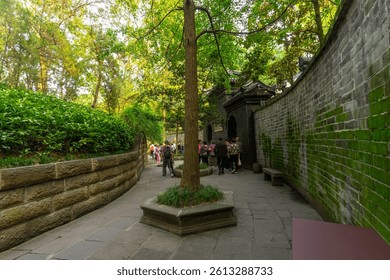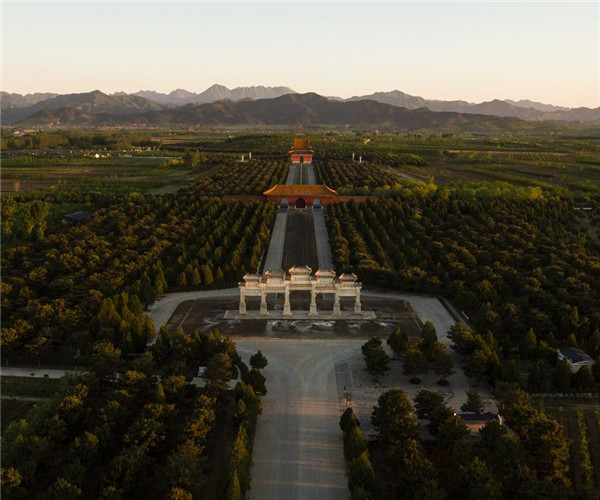Step Back in Time at Liuwan Tombs: An Archaeological Marvel

An Essential Guide to Visiting Liuwan_Tombs
Nestled in the heart of the scenic Haidong region of Qinghai Province, the Liuwan Tombs (柳湾墓地) offer an extraordinary glimpse into the prehistoric past of China. This archaeological marvel, sprawling over an impressive 110,000 square meters, is recognized as the largest and best-preserved public burial site from the late primitive society in the country. Dating back approximately 3,500 to 4,500 years, the tombs provide invaluable insights into the cultural and social dynamics of ancient civilizations.
As you explore the Liuwan Tombs, you’ll encounter a diverse array of burial styles, from single to joint interments, revealing the rich tapestry of life and death in ancient times. The site showcases an impressive collection of artifacts, including intricately designed pottery, stone tools, and unique burial goods, which reflect the artistic and practical skills of the people who once inhabited this region. The vibrant patterns on the pottery, featuring frog motifs and geometric designs, tell stories of an era long gone, while the presence of wooden coffins hints at complex burial practices.
Visiting the Liuwan Tombs is not just an archaeological excursion; it is a journey through time, allowing travelers to connect with the ancient cultures that shaped the landscape of modern China. With a dedicated cultural exhibition center nearby, you can delve deeper into the history and significance of these tombs, making it a must-visit destination for history enthusiasts and curious travelers alike. Whether you’re a lover of history, an adventure seeker, or simply looking for a unique experience, the Liuwan Tombs promise to captivate your imagination and enrich your understanding of China’s past.
In This Guide
- An Essential Guide to Visiting Liuwan_Tombs
- The Rich History and Legends of Liuwan_Tombs
- Main Highlights: What You Absolutely Can’t Miss
- Planning Your Visit: A Practical Guide
- Tickets: Prices, Booking, and Tips
- How to Get There: A Complete Transportation Guide
- Local Cuisine and Accommodation Nearby
- Frequently Asked Questions
- Final Thoughts on Your Trip
The Rich History and Legends of Liuwan_Tombs
Nestled in the serene landscapes of Qinghai province, the Liuwan Tombs (柳湾墓地), also known as the Ludou Liuwan Tombs, are a remarkable testament to China’s ancient civilization, dating back approximately 3,500 to 4,500 years. These tombs, located just 17 kilometers east of Ledou County, span an impressive area of 110,000 square meters, making them one of the largest and most well-preserved prehistoric burial sites in the country.
The discovery of the Liuwan Tombs occurred between 1974 and 1978 when archaeologists unearthed over 1,700 ancient graves, revealing a rich tapestry of burial customs and social structures from the late Neolithic period. The site showcases a diverse array of burial types, including single and joint burials, as well as graves of significant wealth, which illustrate the social stratification that existed in ancient society. Many of the tombs feature wooden coffins and are accompanied by a plethora of burial goods, including stone tools, pottery, and decorative items.
Among the most significant findings are artifacts from the Majiayao culture, characterized by exquisite painted pottery with intricate designs, including frog motifs and geometric patterns. These artifacts not only provide insight into the daily lives and cultural practices of the people who inhabited this region but also highlight their connections with other cultures across China, particularly those in the Central Plains.
The Liuwan Tombs are particularly notable for their pottery, which includes large, beautifully crafted vessels and jars that serve as both functional items and artistic expressions. The craftsmanship displayed in these artifacts is a clear indication of the advanced skills possessed by the artisans of the time, suggesting a society that valued artistry alongside utilitarian needs.
Adjacent to the tombs, visitors can explore the Liuwan Cultural Exhibition Hall, where many of these remarkable artifacts are displayed. This facility serves as both an educational resource and a tribute to the rich cultural heritage of the region, allowing travelers to delve deeper into the lives and beliefs of the ancient inhabitants.
The legends surrounding the Liuwan Tombs are as captivating as the artifacts themselves. Local folklore speaks of the spirits of the departed who are said to protect the land and its people. It is believed that those who respect the ancient burial grounds will find prosperity and protection. This spiritual connection to the site adds an intriguing layer to its historical significance, making it not just a destination for archaeology enthusiasts, but also a place of cultural reverence.
For international travelers, the Liuwan Tombs offer a unique opportunity to step back in time and immerse oneself in the rich history of prehistoric China. The combination of stunning archaeological finds, cultural significance, and captivating legends makes this site a must-visit for anyone interested in understanding the depth of human history in this fascinating region.

Liuwan_Tombs.
Main Highlights: What You Absolutely Can’t Miss
The Liuwan Tombs, nestled in the scenic landscapes of Qinghai province, offer an extraordinary glimpse into the ancient cultures of China. As one of the largest and best-preserved burial sites from the late primitive society, this archaeological wonder spans approximately 110,000 square meters and is over 3,500 years old. Here are the highlights that international travelers absolutely can’t miss during their visit:
Discover Ancient Cultures
At the Liuwan Tombs, you will encounter over 1,700 ancient burial sites that showcase various cultural types, including the Maijia, Qijia, and Xindian cultures. The primary focus is on the Maijia type, characterized by wooden coffins and diverse burial practices ranging from single interments to multiple burials. Each tomb tells a story of ancient life, reflecting the complex social structures and customs of the time.
Marvel at the Artifacts
The tombs have yielded nearly 40,000 artifacts, including over 17,000 pieces of pottery, stone tools, and decorative items. The pottery, especially the colorful ceramic pots adorned with intricate frog and geometric patterns, stands out as a testament to the craftsmanship of the era. Notably, the unique human figurines and gourd-shaped vessels are rare finds that provide insights into the artistic expressions of ancient peoples.
Visit the Liuwan Cultural Exhibition Hall
Adjacent to the tombs, the Liuwan Cultural Exhibition Hall serves as an informative center for visitors. Here, you can delve deeper into the history and significance of the Liuwan Tombs through a variety of displays and exhibitions. This is a perfect opportunity to enrich your understanding of the artifacts and the cultures they represent.
Scenic Surroundings
The tombs are located about 17 kilometers east of Ledou County, surrounded by picturesque landscapes that enhance the overall experience. Take a moment to enjoy the natural beauty of the area, which provides a serene backdrop as you explore this historical site.
Accessibility
Getting to the Liuwan Tombs is straightforward. Travelers can take a long-distance bus from Xining to Ledou County, with frequent services operating throughout the day. The journey is approximately 80 kilometers and provides a glimpse of the stunning scenery of Qinghai along the way.
Practical Information
- Admission Fee: The entrance fee is approximately 20 yuan, making this an affordable cultural excursion.
- Transportation: Local buses and taxis are readily available for convenient access to the site.
Tips for Your Visit
- Timing: Plan your visit during the cooler parts of the day, especially in the summer months, to fully enjoy the outdoor exploration.
- Photography: Capture the intricate details of the artifacts and the stunning landscapes, but be mindful of any restrictions regarding photography within the exhibition hall.
The Liuwan Tombs not only offer a fascinating look into ancient burial practices but also provide a deeper understanding of the cultural heritage that shaped the region. Whether you are a history buff, an archaeology enthusiast, or simply a curious traveler, this site is a must-visit on your journey through Qinghai.

Liuwan_Tombs.
Planning Your Visit: A Practical Guide
When planning your visit to the Liuwan Tombs (柳湾墓地), a treasure trove of ancient history nestled in the lush landscapes of Qinghai Province, here’s everything you need to know to make your experience as enriching and enjoyable as possible.
Getting There
The Liuwan Tombs are located approximately 17 kilometers east of Ledou County, specifically in Liuwan Village. The easiest way to reach the site is by taking a long-distance bus from Xining’s New Ning Bus Station to Ledou. Buses depart every 20 minutes, and the journey takes roughly 80 kilometers, with ticket prices around 10 RMB. Once you arrive in Ledou, local taxis are available for hire to take you directly to the tombs.
Admission Fees and Opening Hours
Visiting the Liuwan Tombs is affordable, with an admission fee of only 20 RMB. The site is generally open from 8 AM to 6 PM, but it’s wise to check local listings for any updates or seasonal changes to opening hours.
What to Expect
The Liuwan Tombs are one of the largest and best-preserved examples of a prehistoric burial ground in China, dating back approximately 3,500 to 4,500 years. Covering an area of around 110,000 square meters, the site features over 1,700 ancient tombs, showcasing various burial practices, including single and collective burials.
You’ll find a range of artifacts, including wooden coffins and numerous grave goods such as tools and pottery, which reflect the diverse cultures of the time, including Majiayao, Qijia, and Xindian cultures. Notably, the colorful pottery, adorned with unique geometric designs, offers insights into the artistic expressions and daily lives of ancient inhabitants.
Nearby Attractions
To enhance your visit, consider exploring the nearby Liuwan Cultural Exhibition Hall, which houses a selection of artifacts unearthed from the tombs, providing deeper context about the region’s historical significance.
Transportation Options
If you prefer not to rely on public transport, taxis are readily available in the city, with a starting fare of 6 RMB for the first 3 kilometers and about 1.1 RMB for each additional kilometer. For a more leisurely experience, consider hiring a private car or joining a guided tour, which may include stops at various historical sites in the area.
Tips for Travelers
- Weather Considerations: The site may close temporarily during adverse weather conditions, such as heavy rain, snow, or fog. Always check the forecast before your visit.
- Respect Local Customs: The tombs are a significant cultural site. It’s important to maintain a respectful demeanor and avoid disturbing any artifacts or grave sites.
- Safety First: Ensure you have travel insurance and consider carrying a first aid kit, especially if you’re venturing into less developed areas around the tombs.
Best Time to Visit
The ideal time to visit the Liuwan Tombs is during the spring and autumn months when the weather is mild, making for a pleasant exploration experience. Summer can be hot, while winter might bring snow, which could limit access to certain parts of the site.
Conclusion
Visiting the Liuwan Tombs offers a fascinating glimpse into ancient Chinese civilization. By following this guide, you can ensure a smooth and enriching experience as you delve into the echoes of the past. Pack your bags, embark on this cultural journey, and let the stories of the Liuwan Tombs unfold before you!

Liuwan_Tombs.
Tickets: Prices, Booking, and Tips
Visiting the Liuwan Tombs (柳湾墓地) offers a unique glimpse into ancient Chinese history, and planning your trip is essential to fully enjoy this remarkable site. Here’s everything you need to know about ticket prices, booking options, and some handy tips for your visit.
Ticket Prices
- Admission Fee: The entry ticket for the Liuwan Tombs is reasonably priced at 20 RMB (approximately $3 USD). This price grants you access to the main site and its fascinating archaeological displays.
Booking Your Tickets
- On-Site Purchase: Tickets can be purchased directly at the entrance. This is straightforward, but during peak tourist seasons, it’s wise to arrive early to avoid long queues.
- Online Booking: For those who prefer to plan ahead, tickets can also be reserved through official travel websites or local tour operators. Make sure to use reputable platforms to ensure a smooth booking process.
Getting There
- Public Transport: The Liuwan Tombs are located about 17 kilometers east of Ledou County. You can take a long-distance bus from Xining’s Xinning Bus Station to Ledou, with buses departing every 20 minutes. The fare is approximately 10 RMB (about $1.50 USD) for the 80-kilometer journey.
- Taxi Services: Taxis are available for a more direct route, and they typically charge around 6 RMB for the first three kilometers, with an additional 1.1 RMB per kilometer thereafter.
Visiting Tips
- Weather Considerations: Be mindful of the weather conditions, as heavy rain or severe weather may lead to temporary closures of certain areas within the tomb complex. Always check for any updates before your visit.
- Guided Tours: Consider joining a guided tour to gain deeper insights into the archaeological significance of the site. Local guides often provide valuable context that enhances your understanding of the tombs and their artifacts.
- Cultural Respect: As with any historical site, maintain a respectful demeanor, especially near grave sites. Photography may be restricted in certain areas, so be sure to adhere to any posted signs.
By following these tips and preparing accordingly, your visit to the Liuwan Tombs will be both enriching and enjoyable, allowing you to explore one of China’s most significant archaeological sites with ease.
How to Get There: A Complete Transportation Guide
To reach the Liuwan Tombs (柳湾墓地), an ancient archaeological site that showcases the burial practices of early Chinese civilizations, you’ll appreciate a well-planned journey. Located approximately 17 kilometers east of Ledou County in Qinghai Province, the tombs are accessible through various modes of transportation. Here’s how to get there:
From Xining
- Bus Services:
- Departure Point: Start your journey from the Xining New Ning Bus Station (新宁汽车站).
- Bus Frequency: Buses to Ledou depart approximately every 20 minutes.
- Travel Duration: The journey takes around 1.5 to 2 hours.
- Cost: Expect to pay about 10 RMB for a one-way ticket.
-
Arrival: Once you arrive at Ledou, you can take a local taxi or find a connecting bus to Liuwan Village.
-
Taxi:
- For those preferring a more direct route, taxis are available in Xining. This option is more expensive but will take you straight to your destination.
- Cost: The fare can vary based on traffic but expect around 150-200 RMB for a direct ride.
From Ledou County
- Local Transportation:
- Upon reaching Ledou, the most common way to continue to the Liuwan Tombs is by local taxi.
- Travel Duration: It is a short drive, approximately 20-30 minutes.
-
Cost: Taxi fares typically start at around 6 RMB for the first 3 kilometers, with an additional cost of about 1.1 RMB for every subsequent kilometer.
-
Public Transport:
- Some public buses may operate routes to Liuwan Village, though schedules can be infrequent. It’s wise to check local listings or ask at your accommodation.
Tips for Travelers
- Cash is King: While some services may accept digital payments, it’s advisable to carry cash (RMB) for bus fares and small local shops.
- Language Barrier: English may not be widely spoken, so having a translation app or a phrasebook can be helpful.
- Timing Your Visit: Ensure to check the opening hours of the Liuwan Tombs and the local transportation schedules as they may vary, especially during holidays or weekends.
Additional Notes
- Consider combining your visit to the Liuwan Tombs with other attractions in the area, such as the Liuwan Cultural Exhibition Hall, which provides deeper insights into the archaeological findings and historical context.
- Be mindful of weather conditions, as they can affect travel plans, especially in the winter months.
With these transportation options and tips, your journey to the Liuwan Tombs will be smooth and enjoyable, allowing you to immerse yourself in the rich history of ancient Chinese culture. Safe travels!

Liuwan_Tombs.
Local Cuisine and Accommodation Nearby
When visiting the Liuwan Tombs (柳湾墓地) in Haidong, Qinghai, you’re in for a unique cultural experience, and there’s plenty to savor in terms of local cuisine and comfortable accommodations nearby.
Local Cuisine
1. Local Restaurants:
-
Xining Lamb Skewers (西宁羊肉串): Just a short journey from the tombs, this local favorite serves tender lamb skewers seasoned with spices. The smoky flavor combined with a hint of chili makes it a must-try.
-
Qinghai Noodles (青海面条): Experience the traditional hand-pulled noodles, often served in a rich broth with a variety of toppings. Many eateries around the tombs offer this comforting dish, perfect after a day of exploring.
-
Tibetan Dishes: Given the proximity to Tibetan culture, don’t miss the chance to try momos (dumplings) and thukpa (noodle soup). These hearty meals reflect the rich culinary heritage of the region.
-
Street Food: As you stroll around the area, look out for food stalls offering snacks like fried dough sticks (油条) and spicy roasted potatoes. These quick bites are a great way to fuel your adventures.
Accommodations Nearby
1. Haidong Hotel (海东酒店): Conveniently located about a 20-minute drive from the Liuwan Tombs, this hotel offers comfortable rooms with modern amenities. The on-site restaurant provides a good selection of local and international dishes, making it a convenient choice for travelers.
2. Qinghai Ethnic Hotel (青海民族酒店): This hotel features a beautiful blend of traditional and modern design, reflecting the local culture. Guests can enjoy spacious rooms and a cultural restaurant that serves authentic Qinghai cuisine.
3. Guesthouses in Ledu (乐都): For a more intimate experience, consider staying in a local guesthouse. Many are situated in Ledu County, which is just a short distance from the tombs. These guesthouses often offer home-cooked meals and a warm, welcoming atmosphere.
4. Budget Hostels: If you’re traveling on a budget, there are several hostels in the area that cater to backpackers. These hostels provide basic accommodations and are great places to meet fellow travelers.
Whether you’re indulging in local delicacies or relaxing in a comfortable room, the area surrounding the Liuwan Tombs offers a blend of experiences that will enhance your visit to this fascinating historical site.

Liuwan_Tombs.
Frequently Asked Questions
Frequently Asked Questions about Liuwan Tombs
-
What are the Liuwan Tombs?
The Liuwan Tombs, also known as the Ludou Liuwan Cemetery, are an archaeological site located in the Qinghai province of China. They are recognized as one of the largest and best-preserved prehistoric communal burial grounds in the country, dating back approximately 3,500 to 4,500 years. The site features a variety of burial types and artifacts that offer insights into the culture and practices of ancient societies. -
How do I get to the Liuwan Tombs?
To reach the Liuwan Tombs, you can take a long-distance bus from Xining’s XinNing Bus Station to Ledu County. Buses leave every 20 minutes, and the journey takes around 1.5 hours, covering approximately 80 kilometers. Tickets usually cost around 10 yuan. -
Is there an entrance fee to visit the Liuwan Tombs?
Yes, there is a nominal entrance fee of 20 yuan to access the site, which also includes entry to the nearby Liuwan Cultural Exhibition Hall where various artifacts are displayed. -
What can I expect to see at the site?
Visitors can explore numerous ancient burial sites, including wooden coffins and various grave goods such as stone tools and pottery. The tombs reflect several cultural types, primarily the Majiayao culture, and showcase intricate pottery designs, including painted vessels and unique geometric patterns. -
Are there any facilities available for visitors?
Yes, there are facilities available at the site, including the Liuwan Cultural Exhibition Hall, where you can view artifacts and learn more about the history of the area. Additionally, basic amenities such as restrooms are typically available. -
What is the best time to visit the Liuwan Tombs?
The most favorable time to visit is during the spring and autumn months when the weather is mild and pleasant. Summer can be hot, while winter temperatures can drop significantly. -
Are guided tours available?
While you can explore the Liuwan Tombs independently, guided tours may also be offered. It’s advisable to check with local travel agencies or the tourism office in Ledu County for options and availability. -
What should I bring when visiting the tombs?
To enhance your experience, consider bringing water, comfortable walking shoes, and a camera. It’s also wise to carry sunscreen and a hat, especially during the warmer months, as there is limited shade on-site.
Final Thoughts on Your Trip
As you conclude your journey through the fascinating Liuwan Tombs, take a moment to reflect on the rich tapestry of history and culture woven into this remarkable site. The vast necropolis, dating back thousands of years, offers a rare glimpse into the lives of ancient societies that once thrived in this region. Each artifact unearthed tells a story—of craftsmanship, beliefs, and the deep connections these communities had with their environment and each other.
Walking among the tombs and their intricate pottery, you are not just a visitor; you become a part of a narrative that spans millennia. The stunning landscapes surrounding the site provide a serene backdrop, inviting contemplation and appreciation for the passage of time.
Whether you are an avid historian, a curious traveler, or simply someone seeking unique experiences, the Liuwan Tombs promise to leave an indelible mark on your journey. Cherish the memories made here, and let the echoes of the past inspire your future adventures. Safe travels, and may your next destination be filled with equally captivating stories.